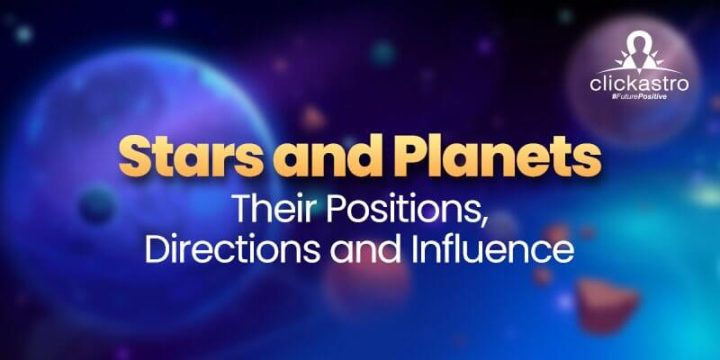Nakshatras and their Nature
The term Nakshatra originates from the words “Naksha” (map) and “tara” (star). In understanding the celestial influences of the planets,
Vedic astrology considers the 27 constellations to be the fundamental element. The 360 degrees of the Zodiac is divided into 27 parts called
Nakshatras ( a constellation of stars). Each extends to 13 degrees and 20 minutes of arc. Nakshatras are also ruled by planets. Rahu and Ketu are also allocated the ownership. The ancient Indian sages and spiritualists considered the 27 constellations or Nakshatra rather than the 12 zodiac star signs that mapped the sky.
Each Nakshatra carries distinct qualities and characteristics and is based on the longitude of the Moon at the time of birth. Male and female natives born in the same birth star or Nakshatra may have different characteristics. The nakshatra is thought to influence our personality traits.
Names of the Nakshatras (Stars), their appearance, nature and Lords are given in the table below.
As stated above, every star or Nakshatra has distinctive properties including their appearance, their nature of influence as well as their rulers. You can know your star’s distinctive properties by referring the table below:
|
Star |
Appearance |
Nature |
Ruler |
| 1 |
Aswini |
3 stars resembling a horse’s face |
Auspicious |
Ketu |
| 2 |
Bharani |
3 stars resembling a female sexual organ. |
Inauspicious |
Venus |
| 3 |
Krittika |
Constellation of 6 stars |
Inauspicious |
Sun |
| 4 |
Rohini |
5 stars resembling an ear. |
Auspicious |
Moon |
| 5 |
Mrigasira |
3 stars like a head. |
Auspicious |
Mars |
| 6 |
Ardra |
Star like a coral head. |
Auspicious |
Rahu |
| 7 |
Punarvasu |
5 stars like a potter’s wheel. |
Semi auspicious |
Jupiter |
| 8 |
Pushya |
3 stars resembling a blood sucker. |
Auspicious |
Saturn |
| 9 |
Ashlesha |
6 stars like a serpent. |
Inauspicious |
Mercury |
| 10 |
Makha |
5 stars like a palanquin. |
Destructive |
Ketu |
| 11 |
Purvaphalguni |
2 stars resembling human eyes. |
Fatal |
Venus |
| 12 |
Uttaraphalguni |
2 stars like eyes. |
Intelligent |
Sun |
| 13 |
Hasta |
5 stars like human fingers. |
Fortunate |
Moon |
| 14 |
Chitra |
1 star like a pearl. |
Auspicious |
Mars |
| 15 |
Swati |
1 star like a sapphire. |
Auspicious |
Rahu |
| 16 |
Vishakha |
5 stars like a potter’s wheel. |
Inauspicious |
Jupiter |
| 17 |
Anuradha |
3 stars resembling an umbrella. |
Success giving |
Saturn |
| 18 |
Jyeshta |
5 stars like a crouching lion. |
Destructive |
Mercury |
| 19 |
Moola |
5 stars like a crouching lion. |
Destructive |
Ketu |
| 20 |
Poorvashada |
2 stars each forming a square. |
Destructive |
Venus |
| 21 |
Uttarashada |
2 stars each forming a square. |
Intelligent |
Sun |
| 22 |
Shravana |
3 stars like an arrow. |
Happy |
Moon |
| 23 |
Dhanishta |
3 stars like an Sun’s head. |
Auspicious |
Mars |
| 24 |
Satabhisha |
100 stars resembling a flower. |
Happy |
Rahu |
| 25 |
Poorvabhadra |
2 stars each forming the legs of a cot. |
Fatal |
Jupiter |
| 26 |
Uttarabhadra |
2 stars each forming the legs of a cot. |
Fortunate |
Saturn |
| 27 |
Revati |
3 stars like a fish. |
Happy |
Mercury |

The Earth is 300 to 400 light-years away from the 27 Nakshatras. The ancient sages divided the zodiac into 12 main Rashi, which aided in the study of the planets’ effects. It was then subdivided further into a sub-divisional system that divided each zodiac into 27-star constellations. Each of these constellations is further divided into four quarters of padas and we have 27*4=108 padas comprising the whole of the zodiac.
Each Nakshatra spans 13 degrees and 20 minutes. It is further subdivided into four Padas, or quarters, each of three degrees and twenty minutes. Thus, the first zodiac sign, Aries, which has 30 degrees, contains the entire 4 padas (13 degrees and 20 minutes) of the first star constellation Ashwini, the entire 4 padas (13:20′) of the second star constellation Bharani, and the first pad (3:20′) of the third-star constellation Kritika, giving each Rashi a total of 9 padas.
Different names of 9 planets
The planets play a major role in prediction techniques in Vedic astrology. Each planet is also known by different names which are given below:
| Planet |
Different Names |
| Sun |
Ravi, Surya, Aditya, Arka and Bhanu |
| Moon |
Chandra, Soma and Sitamsu |
| Mars |
Kuja, Angaraka and Bhoma or Bhumija |
| Mercury |
Budha, Soumya, Gna, Somaja |
| Jupiter |
Guru, Jiva, Brihaspathi, Suri |
| Venus |
Shukra, Sita, Bhrigu and Kavya |
| Saturn |
Sani, Ravija, Asita and Manda |
| Rahu |
Dragons’ Head,Thama and Sarpa |
| Ketu |
Dragon’s Tail, Sikhi |
Planetary Directions
Let us understand what are the directions in which every planet is positioned.
| Direction |
Planet |
| East |
Sun |
| West |
Saturn |
| North |
Mercury |
| South |
Mars |
| North-East |
Jupiter |
| South-East |
Venus |
| North-West |
Moon |
| South-West |
Rahu |
Planetary States
Planets are thought to be in states known as avasthas. Avasthas are the divisions of a planet according to its condition. A planet receives an Avastha according to its degree within a specific Rashi. The ancient text Brihat Parashara Hora Shastra provides us with precise calculations and explanations that allow us to quantify the condition of the planet and accurately predict its outcomes. Avasthas, or planetary states, are classified into several categories. The ten states that describe the physical-mental conditions of the planets are as follows:
- Deepta or exaltation – gives long life, successful work, good family, promising children, wealth, fame, respect and conveyances.
- Swastha or residence in their own house – permanence, happiness, sound education, good position.
- Muditha or residence in friendly sign– good dress, fine taste, sweet scents, flowers, women, position and happiness.
- Santha or planets in auspicious sub-divisions– timely strength and courage, helping relations, comfortable life, health and happiness.
- Saktha or retrograde motion– courage, prosperity, successful position, reputation, wealth, good relations. In retrograde motion, good planets produce happiness and bad planets give evil effects and misery.
- Peedya or planets in the last quarter or Navamsa of the sign – hatred, quarrelsome relations, family dissension, criminal prosecutions, pilfering habits, expulsion from country.
- Deena or planets in unfriendly houses – sickness, meanness, mental worry, derangement in brain, social degradation or excommunication, bigoted persecutions.
- Vikala or planets in combustion – mental disorder, orphanage, many face expulsion from country, public disgrace of children, wife and friends.
- Khala or planets in debilitation – constant losses, vulgar birth, troubles from unexpected sources, quarrels with parents, imprisonment, disease, misery and utter disregard for that which is noble and sacred.
- Bheetha or acceleration – loss due to fire, foes, kings and thieves. Persecution, tortures, disgraceful life, vulgar habits, danger in foreign countries. In predicting the results, it is to be noted that the evil conjuctions and aspects add to the misery and good conjuctions and aspects are beneficial.
Basic Planet Avasthas
Based on the degrees that a planet occupies within a Rashi, the planets are categorised into states that range from infancy to death. The range of a Rashi is 30 degrees. Five sections of six degrees each make up the 30 degrees. The five Avasthas assigned to these sections for the odd Rashis are Bala (infant), Kumara (young adult), Yuva (adolescent), Vridha (advanced), and Mrita (deceased). This order is the opposite for the even Rashis.
Nakshatra directions
In the world of Vedic astrology, each nakshatra, or lunar mansion, is associated with a specific direction that influence various endeavors and activities. The nakshatras are intricately linked with cardinal points, assigning unique energies and influences to different directions. Understanding these directional associations can offer valuable insights into aligning one’s actions and decisions with the cosmic energies represented by each nakshatra. Here’s a breakdown of the nakshatras and their associated directions:
East Direction: Ashwini, Magha, Mula
These nakshatras signify beginnings, growth, and transformation. Activities associated with the east direction, such as home construction or initiating new ventures, can be auspicious when aligned with these nakshatras.
Southeast Direction: Bharani, Purva Phalguni, Purva Ashadha
Associated with vitality, creativity, and passion, these nakshatras infuse dynamism into endeavors. Activities requiring vigor and innovation, like creative projects or entrepreneurial pursuits, find favor when aligned with the southeast direction.
South Direction: Krittika, Uttar Phalguni, Uttar Ashadha
Symbolizing stability, power, and intensity, these nakshatras offer a strong foundation for endeavors. Undertakings seeking longevity and endurance, such as long-term investments or career aspirations, benefit from alignment with the south direction.
Southwest Direction: Rohini, Hasta, Shravana
Nurturing, service, and receptivity characterize these nakshatras, fostering a supportive environment. Activities focused on caregiving, community service, or building strong relationships thrive when aligned with the southwest direction.
West Direction: Mrigashira, Chitra, Dhanishta
Balance, beauty, and social connections define these nakshatras, promoting harmony in endeavors. Events centered on aesthetics, interpersonal relationships, or social gatherings flourish when aligned with the west direction.
Northwest Direction: Ardra, Swati, Shatabhisha
Communication, intellect, and humanitarian values guide these nakshatras, fostering meaningful interactions. Endeavors involving negotiation, intellectual pursuits, or humanitarian efforts gain momentum when aligned with the northwest direction.
North Direction: Punarvasu, Vishakha, Poorva Bhadrapada
Expansion, harmony, and spiritual growth mark these nakshatras, offering abundant opportunities for growth. Ventures aimed at expansion, personal development, or spiritual pursuits thrive when aligned with the north direction.
Northeast Direction: Pushya, Anuradha, Uttara Bhadrapada
Nurturing, protection, and enlightenment characterize these nakshatras, fostering growth and enlightenment. Activities promoting healing, spiritual growth, or protective measures find favor when aligned with the northeast direction.
Nakshatras and Their “Looking” Directions
In addition to their cardinal point associations, nakshatras are also attributed with specific “looking” directions, influencing their suitability for certain activities:
Adhomukha (Facing Downward):
Moola, Aslesha, Vishaka, Krittika, Purvaphalguni, Purvashada, Purvabhadrapada, Bharani, and Magha are suitable for downward-facing acts like digging foundations or mining.
Urdhavamukha (Facing Upward):
Ardra, Pushya, Shravana, Dhanishta, Satabishak, Uttaraphalguni, Uttarashada, Uttarabhadrapada, and Rohini are favorable for upward-facing endeavors such as construction or planting.
Triyangamukha (Facing Forward):
Revati, Chitra, Mrigashirsha, Anuradha, Hasta, Swati, Punarvasu, Ashwini, and Jyeshta are suitable for forward-facing acts like journeys or visiting friends.
The directional associations of nakshatras offer insights into harmonizing one’s actions with cosmic energies, facilitating success, and fulfillment in various endeavors. By aligning activities with the energies represented by each nakshatra and direction, individuals can harness the transformative power of Vedic astrology to navigate life’s journey with purpose and alignment.








My marriage patner how to choose